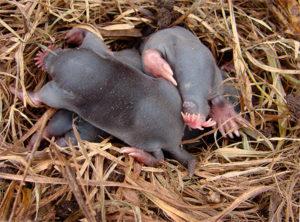Mole starfish: an amazing representative of a kind
The star mole is a rare and unusual mammal. The name is associated with a non-standard appearance. The nose, resembling a multi-pointed star, is the hallmark of the animal world of the New World.
Content
What does the mole starfish look like (photo)
Description of the starship
Name: Starship or starfish
Latin: Condylura cristataClass: Mammals - Mammalia
Squad: Insectivores - Eulipotyphla or Lipotyphla
Family: Mole - Talpidae
 | Habitats: | garden and vegetable garden, underground |
 | What does he eat: | insects, larvae, worms, molluscs |
 | Description: | fast, wild member of the family, common in America |
The second name is starfish. They are distinguished from their relatives by a strong and cylindrical body shape, which has an elongated head on a short neck. The auricles are absent. Their eyesight is poor.
The shape of the front fingers is spatulate. The nails are large and flattened. The paws are turned outward. This contributes to the convenient carrying out of earthworks. The hind legs are five-fingered.
Dimensions and features
The animal is small. The size in length varies between 10 - 13 cm. The length of the tail is 8 cm. The tail is longer than that of other moles. Rigid wool allows you to save fat in winter. By the cold season, the animal increases by 4 times. Weight reaches 50 - 80 g.
The tentacles of the nose are no more than 4 mm in size. With the help of blood vessels and nerve endings on the tentacles, the starfish recognizes its prey. Habitat:
- eastern region of North America;
- southeast Canada.
In the southern part you can meet representatives of a smaller size. They live in a humid environment, characteristic of swampy areas, bogs, peat bogs, overgrown forests and meadows. In a dry environment, they can be located at a distance of no more than 300 - 400 m from the water.
Life
Similar to their relatives are engaged in the creation of labyrinths underground. Earth mounds are signs of burrows. Some tunnels lead to a reservoir. In part of the tunnels there are equipped chambers for rest. They are lined with dry plants, leaves, twigs.
The upper passage is intended for hunting, the deep hole is for shelter from predators and procreation. The tunnels are 250 to 300 m long. They move faster than rats.
They are not afraid of the water element. They dive and swim very well. They can also hunt on the bottom. In winter, they are often found under ice in the water. They do not hibernate. They hunt at night and during the day for underwater inhabitants.
Starfish are the most active among the rest of the representatives. The social environment consists of unstable groups on the site. However, each individual has separate underground rooms for relaxation. On 1 hectare there are from 25 to 40 individuals. Colonies can quickly disintegrate. Females and males communicate not only during the mating season.
The animal is afraid of the cold. Freezing may die.
Reproduction
In the group, partial monogamy can be noted. There are no conflicts of heterosexual individuals that make up a married couple.
The mating season falls in the spring. In the northern habitat, this process begins in May and ends in June. In the southern region, it starts in March and ends in April. The gestation period is 1,5 months. One litter has 3-4 cubs, in rare cases up to 7.
The cubs appear naked, the stars are almost invisible on the spouts. They become independent after a month. They are starting to explore the areas. At 10 months, matured offspring reach sexual maturity. And the next spring is able to breed.
Lifespan
The animal lives no more than 4 years. It all depends on the conditions of life. When caught in captivity, it can live up to 7 years. In the wild, the number of starfish is constantly decreasing. There is no threat of extinction yet, as the natural balance helps them survive.
Food
Moles hunt in any conditions. They feed on earthworms, molluscs, larvae, various insects, small fish and various small things. They can eat a small frog and a mouse. A voracious animal eats an amount of food that is equal to its weight. The rest of the time, the norm is no more than 35 g of feed. In search of food during the day, they make from 4 to 6 sorties. In between, they rest and digest their prey.
The speed of food absorption is the fastest in the world. Searching and swallowing takes less than a second. Due to the unusual structure of the teeth, they can tightly cling to the victim. The teeth are like tweezers.
Natural enemies
Starfish are food for night birds, dogs, skunks, foxes. Of underwater ill-wishers, it is worth noting largemouth bass and bullfrogs. In winter, predatory animals dig moles out of their holes. Falcons and owls can also feast on such prey.
Interesting Facts
In the Guinness Book of Records, he is noted as the fastest mammal - a hunter. For 8 milliseconds, the animal evaluates the prey.
You can study the work of mobile outgrowths using a high-speed video camera. The movements of the outgrowths are not perceptible to the human eye.
The diameter of the "star" is up to 1 cm. It is smaller than the nail of a male finger. Some receptors are only sensitive to pressure, others only to rubbing.
Conclusion
Many biologists believe that the starfish can be attributed to a successful and ingenious evolutionary invention of nature. Its physiological and anatomical abilities never cease to amaze scientists.
Previous